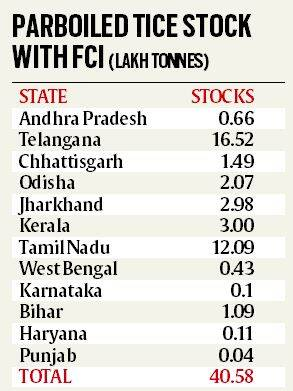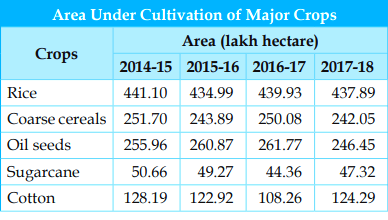Agriculture
Parboiled Rice
- 19 Apr 2022
- 7 min read
For Prelims: Parboiled Rice, RIce, Kharif Crop, Rabi Crop
For Mains: Major Crops Cropping Patterns in Various Parts of the Country
Why in News?
Recently, the Centre announced to stop the purchase of excess parboiled rice after which Telangana Chief Minister and members of his Cabinet staged a dharna demanding a uniform paddy procurement policy.
What is Parboiled Rice?
- About:
- The dictionary meaning of ‘parboil’ is ‘partly cooked by boiling’.
- Thus, the expression parboiled rice refers to rice that has been partially boiled at the paddy stage, before milling.
- Parboiling of rice is not a new practice, and has been followed in India since ancient times.
- However, there is no specific definition of parboiled rice of the Food Corporation of India or the Ministry of Consumer Affairs, Food and Public Distribution.
- The dictionary meaning of ‘parboil’ is ‘partly cooked by boiling’.
- Processes for Parboiling Rice (Examples):
- The Central Food Technological Research Institute (CFTRI), Mysuru, uses a method in which the paddy is soaked in hot water for three hours, in contrast to the more common method in which paddy is soaked for 8 hours.
- The water is then drained and the paddy steamed for 20 minutes. Also, the paddy is dried in the shade in the method used by the CFTRI, but is sun-dried in the common method.
- The Paddy Processing Research Centre (PPRC), Thanjavur follows a method known as the chromate soaking process.
- It uses chromate, a family of salt in which the anion contains both chromium and oxygen, which removes the odour from the wet rice.
- The Central Food Technological Research Institute (CFTRI), Mysuru, uses a method in which the paddy is soaked in hot water for three hours, in contrast to the more common method in which paddy is soaked for 8 hours.
- Rice Varieties Suitable for Parboiling:
- Generally, all varieties can be processed into parboiled rice, but it is ideal to use long slender varieties to prevent breakage during milling.
- However, aromatic varieties should not be parboiled because the process can make it lose its aroma.
What are the Advantages and Disadvantages?
- Advantages:
- Parboiling makes rice tougher which reduces the chances of the rice kernel breaking during milling.
- Parboiling also increases the nutrient value of the rice.
- Parboiled rice has a higher resistance to insects and fungi.
- Disadvantages:
- The rice becomes darker and may smell unpleasant due to prolonged soaking.
- Besides, setting up a parboiling rice milling unit requires a higher investment than a raw rice milling unit.
Why has the Government has Decided to Stop Purchases?
- According to the government, the Food Corporation of India cannot procure surplus parboiled rice due to sufficient stocks.

- Also, there is no demand for such grain under the Public Distribution System (PDS).
- The Ministry pegs the parboiled rice demand at 20 LMT per annum for distribution under the National Food Security Act, 2013.
- According to the Ministry, the demand for parboiled rice has come down in recent years.
- In the last few years, production in parboiled rice-consuming states such as Jharkhand, Kerala and Tamil Nadu has increased, resulting in less movement to the deficit states.
- Earlier, the Food Corporation of India used to procure parboiled rice from states such as Telangana to supply to these states. But in recent years, parboiled rice production has increased in these states.
- Telangana is a surplus parboiled producing region and does not consume parboiled rice, but only produces which is always surplus and delivered to FCI.
What are the Key Highlights about Rice?
- It is a kharif crop which requires high temperature (above 25°C) and high humidity with annual rainfall above 100 cm.
- Rice is grown in the plains of north and north-eastern India, coastal areas and the deltaic regions.
- West Bengal tops the list of rice-producing states followed by Uttar Pradesh and Punjab.
UPSC Civil Services Examination, Previous Year Questions (PYQs)
Q. With reference to the cultivation of Kharif crops in India in the last five years, consider the following statements: (2019)
- Area under rice cultivation is the highest.
- Area under cultivation of jowar is more than that of oilseeds.
- Area of cotton cultivation is more than that of sugarcane.
- Area under sugarcane cultivation has steadily decreased.
Which of the statements given above are correct?
(a) 1 and 3 only
(b) 2, 3 and 4 only
(c) 2 and 4 only
(d) 1, 2, 3 and 4
Ans: (a)
- Rice is one of the most important food crop. India has the largest area under rice cultivation.
- Hence, statements 1 and 3 are correct, and statements 2, 4 and 5 are not correct. Therefore, option (a) is the correct answer.
Q. Consider the following crops: (2013)
- Cotton
- Groundnut
- Rice
- Wheat
Which of these are Kharif crops?
(a) 1 and 4
(b) 2 and 3 only
(c) 1, 2 and 3
(d) 2, 3 and 4
Ans: (c)
- India has three cropping seasons i.e., Rabi, Kharif and Zaid. Rabi crops are sown in winter from October to December and harvested in summer from April to June.
- Kharif crops are grown with the onset of monsoon in different parts of the country and these are harvested in September-October.
- In between the Rabi and the Kharif seasons, there is a short season during the summer months known as the Zaid season. Some of the crops produced during ‘Zaid’ are watermelon, muskmelon, cucumber, vegetables and fodder crops.
- Kharif Crops: Rice, Maize, Sorghum, Pearl Millet or Bajra, Finger Millet or Ragi (cereals), Arhar (pulses), Soyabean, Groundnut (oilseeds), Cotton, etc. Hence, 1 ,2 and 3 are correct.
- Rabi Crops: Wheat, Barley, Oats (cereals), Chickpea or Gram (pulses), Linseed, Mustard (oilseeds), etc. Hence, 4 is not correct.
- Therefore, option (c) is the correct answer.







